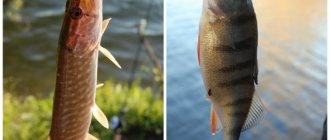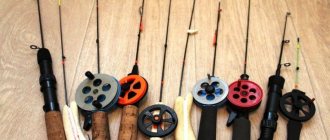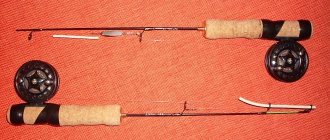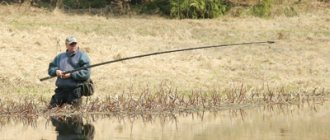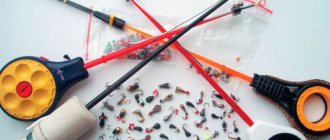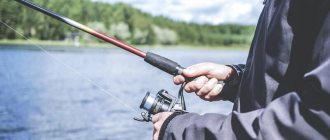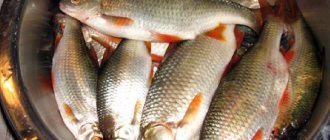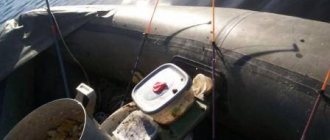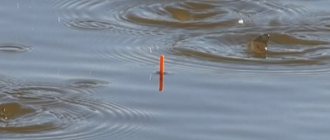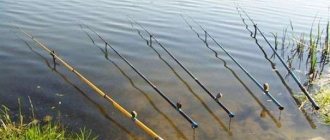Yuri 09/28/2020 1222
Every experienced fisherman has his favorite proven gear, with which both frequent bites and heavier specimens are all winter paraphernalia that bring good luck. Convenience and easy installation of gear is especially necessary in winter. At this time there is severe frost, knee-deep snow, and even heavy equipment with which you need to walk tens of kilometers.
In this regard, we suggest considering the talents of folk craftsmen, among whom we liked the fishing rod based on a champagne cork.
What types of fishing rods are made from champagne corks?
Winter tackle is made and selected based on the fish that we are supposed to catch. Perch, pike perch, and pike are caught with a medium-hard whip with a diameter of 2 mm. The handle must contain a neoprene coating.
Crucian carp prefers inexpensive tackle with a hard whip - a champagne cork is perfect for this. These are universal fishing rods that can be used for fishing with jigs, reelless baits and spinners. They are universal, and the nod is regulated by a special mechanism.
Method for making winter gear
A nozzle jig requires light, convenient, miniature tackle. Today, only basic balalaikas are available for sale as the smallest fishing rod. Here the warm foam handle becomes heavy on a cold pond after a long fishing trip.
Interesting! We will use simple materials at hand and the method of folk craftsmen, and as a result we will get a good fishing rod for ice fishing.
- Choose a reliable, strong whip. You can take the tip from a spinning rod or an old fishing rod for winter.
- Take a champagne cork and drill a hole. We choose a drill diameter such that it is smaller than the diameter of the whip.
- Coat the thick end of the whip with Moment glue from a small tube and insert it into the previously drilled hole. After a long period of hardening, it is necessary to equip the fishing rod and reel in the fishing line. Here we offer two methods: We cut the round sides of the fishing line, or make cuts along the cork. Accordingly, we wind either across or along our base.
- Next, we pull the cambric onto the whip until it stops against the plug, through which we pass and fix the fishing line.
The only disadvantage of the cork is that when fishing at great depths (over 10 m), there is not enough space to wind the fishing line. However, for fishing at medium depths, this is the best solution.
- Advantage! The hook with the jig clings to the cork perfectly and does not become dull. And the light handle fits nicely in the hand and does not freeze.
The nod material for such a fishing rod is boar bristle. The nod is adjusted to the weight of the jig. It will be quite enough for a week's fishing. Even in the cold it is easy to change it without tying the jig. We bend the tip of the bristles, insert it into the cambric that is already on, and pass it through the loop. We remove the cambric from the old bristles and put it on the new one. We put the line into the loop with the already tied jig.
Making a fishing rod with your own hands
You can make the simplest fishing rod from a wine cork if you follow the instructions:
- Before you make a fishing rod, you need to pick up a whip. For this part, you can use the top element of a spinning rod or a similar part of an old winter fishing rod.
- Now you can make the rod handle. We take several corks and make a hole exactly in the middle. The diameter of the drill used for this should be smaller than the diameter of the whip.
- Coat the thick end of the whip and the inner surfaces of the hole in the cork with glue (it is better to use “Moment”). Now the whip needs to be placed in the hole. Allow the structure to dry thoroughly.
- Now you need to make a nod. Cut a thin strip from the X-ray film, rounded at one end. Make a hole at this end.
- Pull a movable ring of cambric two-core wire onto the whip near the handle. A fishing line is passed through the cambric and then fixed. The nod is located between the cambric and the cork.
- The nod needs to be adjusted. First, position it so that the edge protrudes 5 mm beyond the cambric, and then bend it and glue it to the cambric.
- After this you need to lay the fishing line. This can be done in two ways: trim the sides of the cork and wind the fishing line around the circumference, or make notches on the cork and lay the fishing line along the base.
It is recommended to perform the first tests of a fishing rod without an attachment with a cork reel at home, so that unforeseen situations do not occur during fishing.
A homemade winter fishing rod made from a wine cork will not only save money, but also make a good catch without much effort. In addition, you can take a lot of such products with you, which means there will be no hitches in the event of a breakdown or other trouble.
Advantages of a cork fishing rod
This fishing rod weighs only a few grams. When we land a big catch, we are not afraid and throw it aside - it will not get lost in the snow and will not drown. The cork also warms the palm and is held with just three fingers.
- Advice! Excellent play with a jig is obtained by tapping the end of the cork with your palm. The jig plays on the bottom layer of silt and attracts the long-awaited trophy.
The plug is installed in different ways - with a hole on the side, in the center of the end or away from the central part. For installation, we use the flat surface of the conical plug - the fishing rod stands comfortably and does not tip over, which cannot be said about slingshots, where the mechanism constantly weakens or freezes in the cold. For additional stability, you can install a second plug on the thin side of the whip.
Finnish, Norwegian and American products are certainly in great demand. However, a comfortable fishing rod made with your own efforts, into which you put your soul and energy, will undoubtedly bring a good catch to its creator.
TAGS:
Photos of winter fishing rods
Note!
How to attach live bait to a girder - the best methods and step-by-step description of how to properly attach live bait (115 photos and videos)Flags for winter fishing - choice of gear, methods of catching predators and an overview of the most effective techniques (120 photos)
Winter baits: useful tips on choosing gear, secrets of experienced fishermen and features of their use (video + 110 photos)
Read here What you need for winter fishing - tips and tricks for fishing beginners and a minimum list of necessary equipment (125 photos + video)
Help the project, share on social networks
0
Tags
Carp Buffalo Spring Vobla Asp Winter Crucian Rudd Summer Fishing baits Lower Volga Perch Autumn Fisherman's reminder Lures Bite forecast Fishing in Astrakhan Fishing baits Fishing tackle Fishing secrets Catfish Fishing methods Pike perch Catch Pike
